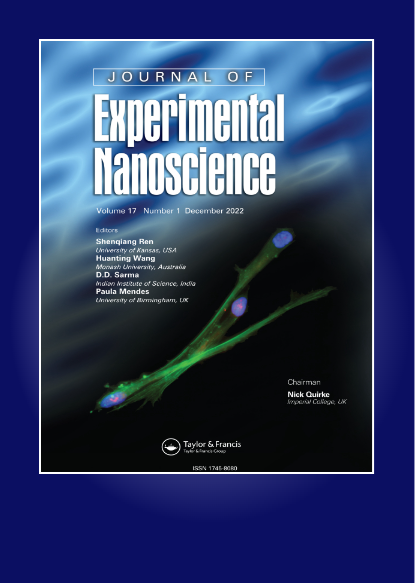设计和合成用于治疗人类食管癌的铜纳米颗粒:介绍一种新的化疗补充剂
IF 2.6
4区 材料科学
Q2 CHEMISTRY, MULTIDISCIPLINARY
引用次数: 8
摘要
摘要本研究以薄荷提取物为还原剂/稳定剂,采用生态友好的方法合成了铜纳米粒子。利用FE-SEM、EDX和UV-Vis等先进技术对制备的纳米颗粒的形态和物理化学特征进行了测定。对合成的铜NPs进行了抗氧化和抗人食管癌试验。研究了生物合成Cu NPs对人食管鳞状细胞癌(KYSE-270)、人高加索食管癌(OE33)和胃食管交界处腺癌(ESO26)细胞系的体外细胞毒和抗食管癌作用。MTT实验显示,Cu NPs对KYSE-270、OE33和ESO26癌细胞的抑制作用呈时间和浓度依赖性。Cu NPs对KYSE-270、OE33和ESO26癌细胞的IC50分别为241、278和240µg/mL。采用DPPH法测定铜NPs的抗氧化活性。IC50值表明,铜NPs具有较高的抗氧化活性。纳米颗粒的抗食管癌作用似乎是由于其抗氧化作用。本文章由计算机程序翻译,如有差异,请以英文原文为准。
Design and synthesis of copper nanoparticles for the treatment of human esophageal cancer: introducing a novel chemotherapeutic supplement
Abstract In this study, copper nanoparticles (Cu NPs) were synthesized in an eco-friendly pathway applying Mentha piperita extract as reducing/stabilizing agent. The morphological and physicochemical features of the prepared nanoparticles were determined using several advanced techniques like FE-SEM, EDX, and UV–Vis studies. The as synthesized Cu NPs was explored in the antioxidant and anti-human esophageal cancer tests. The in vitro cytotoxic and anti-esophageal cancer effects of biologically synthesized Cu NPs against human esophageal squamous cell carcinoma (KYSE-270), human caucasian esophageal carcinoma (OE33), and adenocarcinoma of the gastroesophageal junction (ESO26) cancer cell lines were assessed. The anti-esophageal cancer properties of the Cu NPs could significantly remove KYSE-270, OE33, and ESO26 cancer cell lines in a time and concentration-dependent manner by MTT assay. The IC50 of the Cu NPs were 241, 278, and 240 µg/mL against KYSE-270, OE33, and ESO26 cancer cell lines. The antioxidant activity of Cu NPs was determined by DPPH method. The Cu NPs showed the high antioxidant activity according to the IC50 value. It seems that the anti-human esophageal cancer effect of recent nanoparticles is due to their antioxidant effects.
求助全文
通过发布文献求助,成功后即可免费获取论文全文。
去求助
来源期刊

Journal of Experimental Nanoscience
工程技术-材料科学:综合
CiteScore
4.10
自引率
25.00%
发文量
39
审稿时长
6.5 months
期刊介绍:
Journal of Experimental Nanoscience, an international and multidisciplinary journal, provides a showcase for advances in the experimental sciences underlying nanotechnology and nanomaterials.
The journal exists to bring together the most significant papers making original contributions to nanoscience in a range of fields including biology and biochemistry, physics, chemistry, chemical, electrical and mechanical engineering, materials, pharmaceuticals and medicine. The aim is to provide a forum in which cross fertilization between application areas, methodologies, disciplines, as well as academic and industrial researchers can take place and new developments can be encouraged.
 求助内容:
求助内容: 应助结果提醒方式:
应助结果提醒方式:


